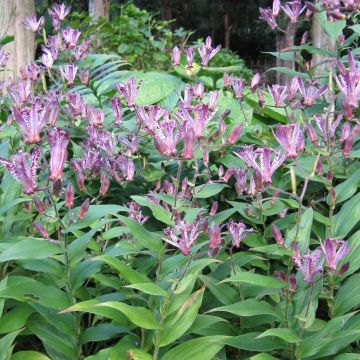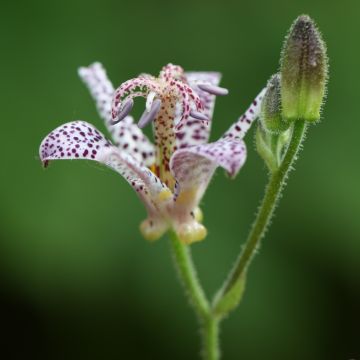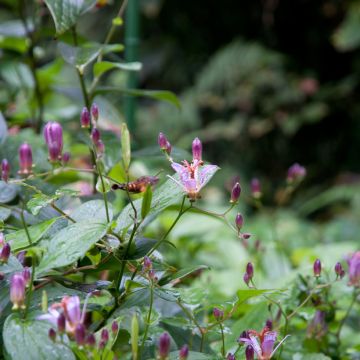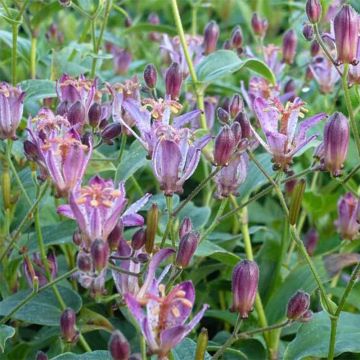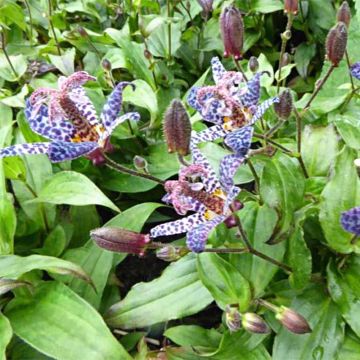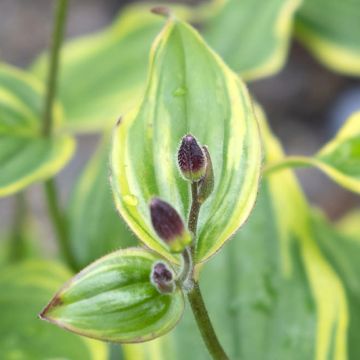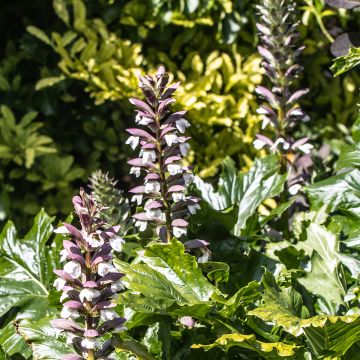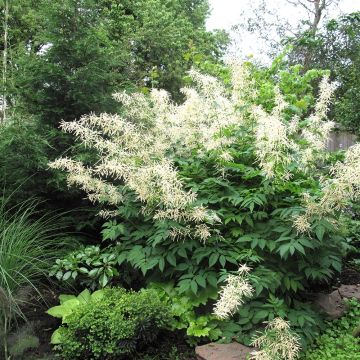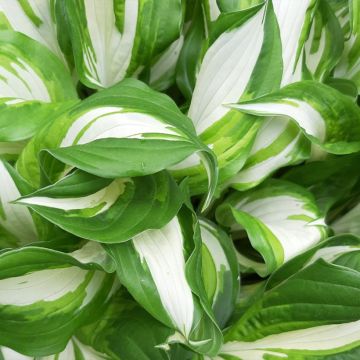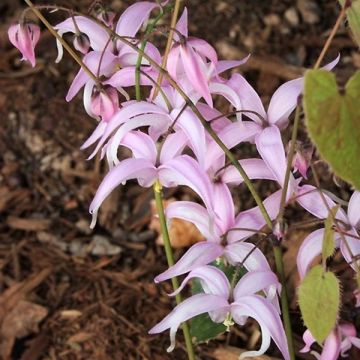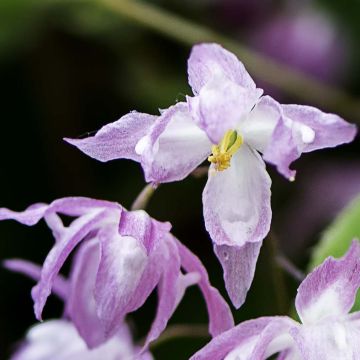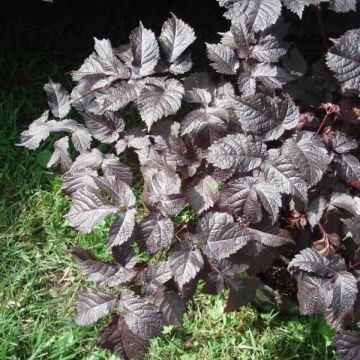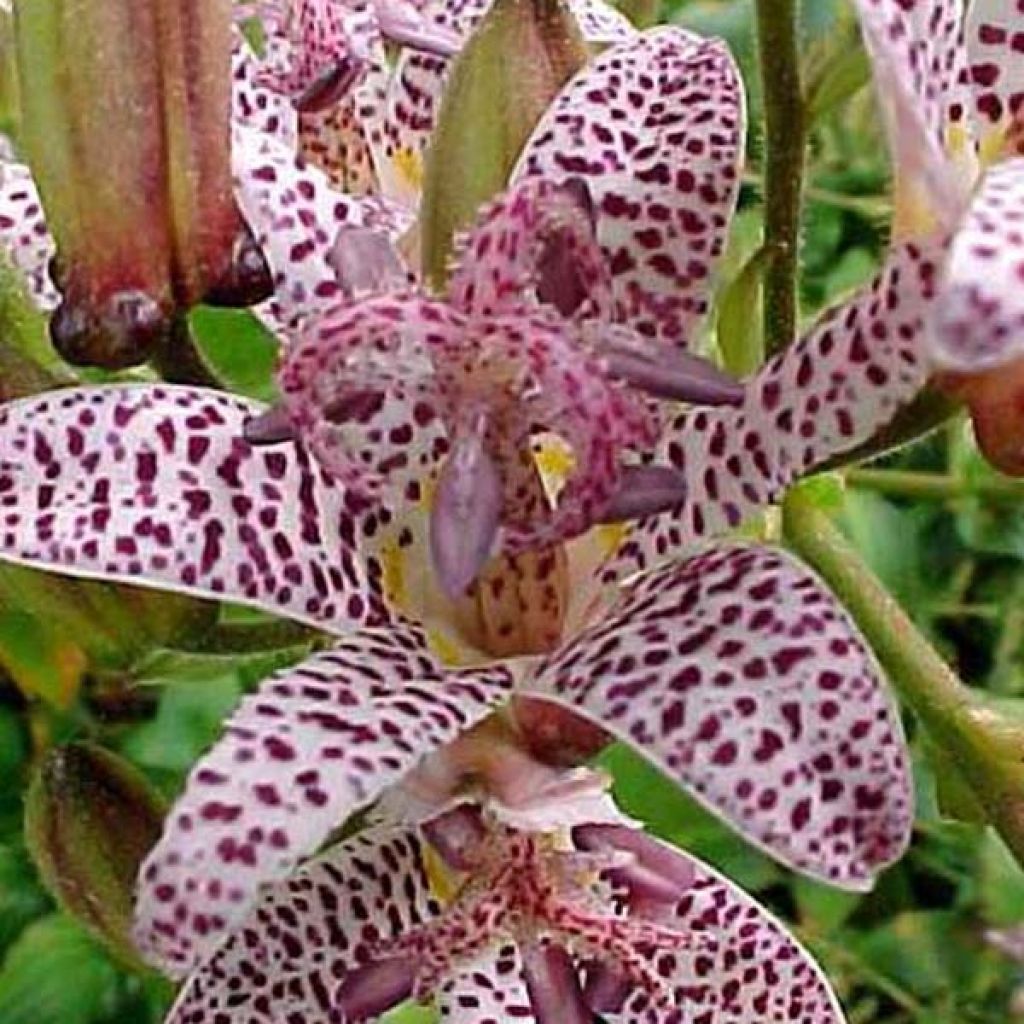

Tricyrtis hirta Miyazaki - Toad Lily
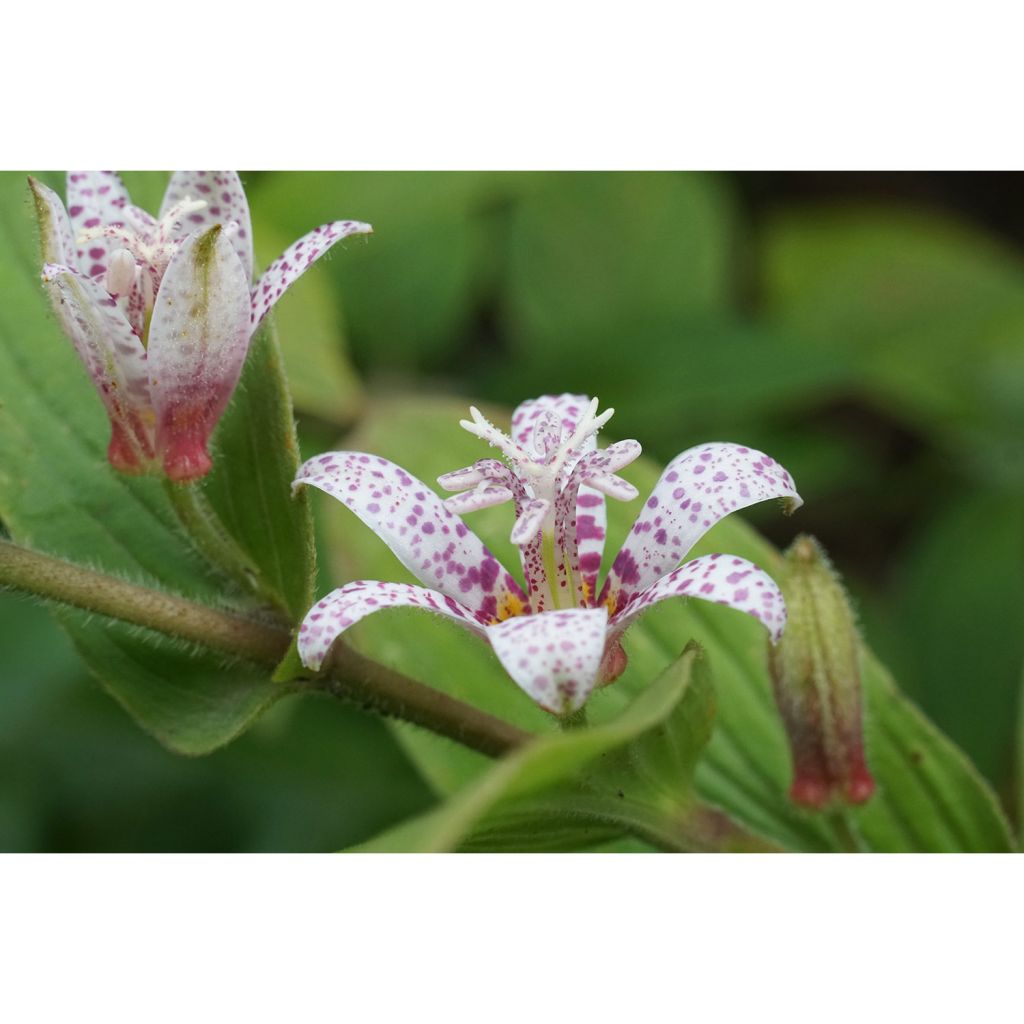

Tricyrtis hirta Miyazaki - Toad Lily
Tricyrtis hirta Miyazaki - Toad Lily
Tricyrtis hirta Miyazaki
Toad Lily
This item cannot be shipped to the selected country
Delivery charge from €5.90
More information
Schedule delivery date,
and select date in basket
This plant carries a 12 months recovery warranty
More information
We guarantee the quality of our plants for a full growing cycle, and will replace at our expense any plant that fails to recover under normal climatic and planting conditions.
From €5.90 for pickup delivery and €6.90 for home delivery
Express home delivery from €8.90.
Does this plant fit my garden?
Set up your Plantfit profile →
Description
The Tricyrtis hirta 'Miyazaki', also called orchid lily, is a splendid perennial with white flowers, punctuated with purple spots.
Originally from Japan, the Tricyrtis is also called orchid lily or toad lily because of the numerous spots present on the petals. Flowering in autumn, the flowers offer a wide range of colours ranging from pure white to dark purple. It forms a rhizomatous stump and spreads rapidly in cool and very humus-bearing soils. It likes partial shade and naturally grows in the edge of the undergrowth, under large trees. Behind its delicate and fragile appearance hides a hardy perennial in almost all regions, it is not afraid of frost but tolerates drought poorly in summer.
The 'Miyazaki' variety has a very original flowering. In early autumn, the plant produces white flowers, speckled with purple. The flowers are carried at a height of 60cm (24in) and measure about 4-5cm (2in) in diameter. Also original, the leaves are green with black spots. Still too little used in our gardens, it will happily share the territory of hostas and ferns, offering its flowers in a season when most other undergrowth flowers are faded. While early frosts can harm its flowering, it is a very hardy plant that will bring an exotic and unexpected touch to a shady rockery. Perfectly at ease among the round and mossy stones of a Japanese garden, it also grows very well in a pot on a shaded terrace, where its lanceolate foliage is decorative from spring to autumn.
Attention, the young shoots are often targeted by small gray slugs!
Combine it with Blue Angel hostas, 'Honorine Jobert' Japanese anemones, and 'Preciosa' or 'Shojo' serrata hydrangeas for a colorful late season border with exotic vibes.
Report an error about the product description
Tricyrtis hirta Miyazaki - Toad Lily in pictures
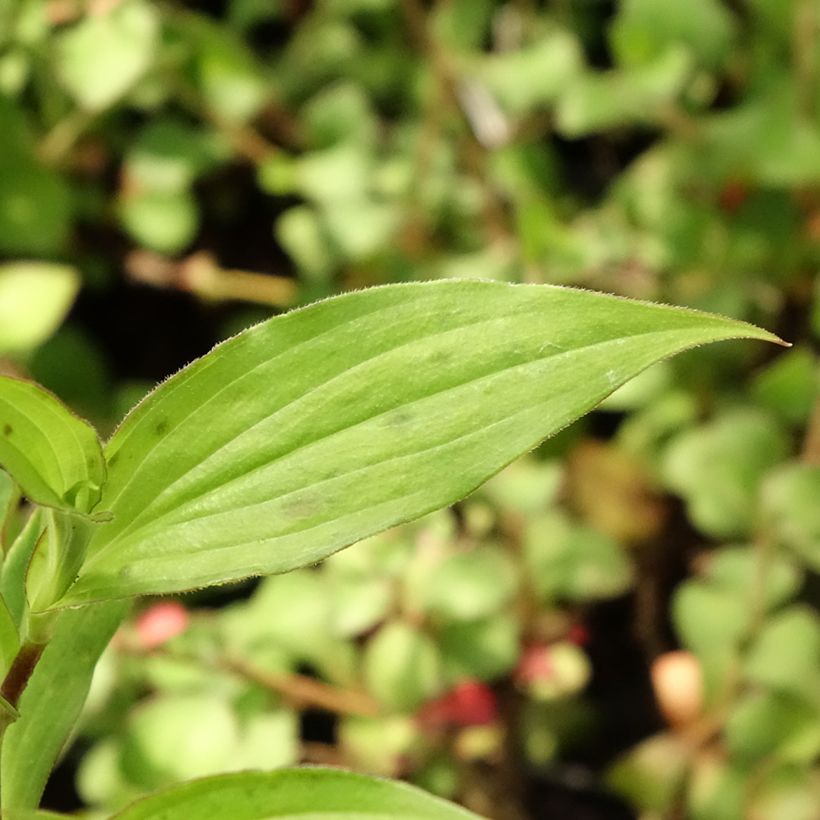

Flowering
Foliage
Plant habit
Botanical data
Tricyrtis
hirta
Miyazaki
Convallariaceae
Toad Lily
Cultivar or hybrid
Other Tricyrtis - Japanese Toad Lily
Planting and care
Plant your Miyazaki Trycirtis hirta in a fairly shaded to shaded position in hot regions however, it can be planted in light sun in the north, if watering is consistent and the soil remains constantly moist.
Plant it in a fresh, humus-bearing, fairly rich, slightly acidic or neutral soil, sheltered from winds that would bend the tall flowering stems, both in the ground and in pots. Flowering will be later if the summer is dry, returning with September rains, which is not too serious in regions where autumn is mild and long. However, when frosts come early, a late flowering will be destroyed by the cold. In this case, the soil should not completely dry out in spring and summer, which means the plant should be regularly watered during periods of summer drought. Mulching will help keep the soil cool at the base of the plant.
Beware, young shoots are often targeted by small gray slugs. Spread ashes, crushed eggshells, or if not available, use granules suitable for organic farming (which are not harmful to animals that consume slugs).
Planting period
Intended location
Care
-
, onOrder confirmed
Reply from on Promesse de fleurs
Shade-loving perennials
Haven't found what you were looking for?
Hardiness is the lowest winter temperature a plant can endure without suffering serious damage or even dying. However, hardiness is affected by location (a sheltered area, such as a patio), protection (winter cover) and soil type (hardiness is improved by well-drained soil).

Photo Sharing Terms & Conditions
In order to encourage gardeners to interact and share their experiences, Promesse de fleurs offers various media enabling content to be uploaded onto its Site - in particular via the ‘Photo sharing’ module.
The User agrees to refrain from:
- Posting any content that is illegal, prejudicial, insulting, racist, inciteful to hatred, revisionist, contrary to public decency, that infringes on privacy or on the privacy rights of third parties, in particular the publicity rights of persons and goods, intellectual property rights, or the right to privacy.
- Submitting content on behalf of a third party;
- Impersonate the identity of a third party and/or publish any personal information about a third party;
In general, the User undertakes to refrain from any unethical behaviour.
All Content (in particular text, comments, files, images, photos, videos, creative works, etc.), which may be subject to property or intellectual property rights, image or other private rights, shall remain the property of the User, subject to the limited rights granted by the terms of the licence granted by Promesse de fleurs as stated below. Users are at liberty to publish or not to publish such Content on the Site, notably via the ‘Photo Sharing’ facility, and accept that this Content shall be made public and freely accessible, notably on the Internet.
Users further acknowledge, undertake to have ,and guarantee that they hold all necessary rights and permissions to publish such material on the Site, in particular with regard to the legislation in force pertaining to any privacy, property, intellectual property, image, or contractual rights, or rights of any other nature. By publishing such Content on the Site, Users acknowledge accepting full liability as publishers of the Content within the meaning of the law, and grant Promesse de fleurs, free of charge, an inclusive, worldwide licence for the said Content for the entire duration of its publication, including all reproduction, representation, up/downloading, displaying, performing, transmission, and storage rights.
Users also grant permission for their name to be linked to the Content and accept that this link may not always be made available.
By engaging in posting material, Users consent to their Content becoming automatically accessible on the Internet, in particular on other sites and/or blogs and/or web pages of the Promesse de fleurs site, including in particular social pages and the Promesse de fleurs catalogue.
Users may secure the removal of entrusted content free of charge by issuing a simple request via our contact form.
The flowering period indicated on our website applies to countries and regions located in USDA zone 8 (France, the United Kingdom, Ireland, the Netherlands, etc.)
It will vary according to where you live:
- In zones 9 to 10 (Italy, Spain, Greece, etc.), flowering will occur about 2 to 4 weeks earlier.
- In zones 6 to 7 (Germany, Poland, Slovenia, and lower mountainous regions), flowering will be delayed by 2 to 3 weeks.
- In zone 5 (Central Europe, Scandinavia), blooming will be delayed by 3 to 5 weeks.
In temperate climates, pruning of spring-flowering shrubs (forsythia, spireas, etc.) should be done just after flowering.
Pruning of summer-flowering shrubs (Indian Lilac, Perovskia, etc.) can be done in winter or spring.
In cold regions as well as with frost-sensitive plants, avoid pruning too early when severe frosts may still occur.
The planting period indicated on our website applies to countries and regions located in USDA zone 8 (France, United Kingdom, Ireland, Netherlands).
It will vary according to where you live:
- In Mediterranean zones (Marseille, Madrid, Milan, etc.), autumn and winter are the best planting periods.
- In continental zones (Strasbourg, Munich, Vienna, etc.), delay planting by 2 to 3 weeks in spring and bring it forward by 2 to 4 weeks in autumn.
- In mountainous regions (the Alps, Pyrenees, Carpathians, etc.), it is best to plant in late spring (May-June) or late summer (August-September).
The harvesting period indicated on our website applies to countries and regions in USDA zone 8 (France, England, Ireland, the Netherlands).
In colder areas (Scandinavia, Poland, Austria...) fruit and vegetable harvests are likely to be delayed by 3-4 weeks.
In warmer areas (Italy, Spain, Greece, etc.), harvesting will probably take place earlier, depending on weather conditions.
The sowing periods indicated on our website apply to countries and regions within USDA Zone 8 (France, UK, Ireland, Netherlands).
In colder areas (Scandinavia, Poland, Austria...), delay any outdoor sowing by 3-4 weeks, or sow under glass.
In warmer climes (Italy, Spain, Greece, etc.), bring outdoor sowing forward by a few weeks.

































